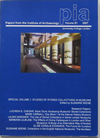Studies of Stored Collections in Museums
Papers from the Institute of Archaeology, Volume S1. University College London Institute of Archaeology, 2007. ISSN 0965 9315
Institute of Archaeology, 2007. ISSN 0965 9315
A collection of useful papers arising from the MA in Museum Studies at UCL. Online, Open Access
Contents
Store tours: accessing museums' stored collections Lucinda Caesar
Open storage has been adopted by many museums as an access strategy. This report explores the use of a particular interpretation method: guided tours of the stores of the Science Museum, London. Are store tours a worthwhile investment? Should store tours be used as an interpretative medium for accessing stored collections on a national level? Are store tours the best tool to engage the public in stored collections? What do store tours provide as a means of accessing or promoting engagement in museum’s stored collections? Are they indeed the access tool of the future? This paper reviews these questions, drawing on the data from a series of store tours hosted in 2004 and 2005.
Zoo Store 1 at the Natural History Museum: meeting national standards? Mark Carnall
The Natural History Museum (NHM), London is at the forefront of natural history science, and a major player in developing standards for the care of these collections in museums. This paper examines how the NHM’s collections storage compares to the standards and policies to which the museum aspires. Zoo Store 1, one of the NHM’s oldest storerooms, is used as a case study. The investigation found that the store falls short of the aspired standards, but significant progress has been made in the last two years. Reasons range from inherited problems to the sheer time that it takes to implement a series of standards across very large collections and numbers of staff.
The use of stored collections in some London museums Laura Gardner
Little is known about how the stored collections of museums are used. The amount and nature of use in several London museums was analysed by means of a survey sent to a sample of museums and departments. Awareness among museum visitors of the existence of collections was also investigated. A majority of respondents would like their collections used more. A second survey was conducted on visitors to London museums. Contrary to the findings of earlier work in the US and Australia, visitors were well-informed about the existence and uses of stored collections, but less knowledgeable about their size.
The effects of online catalogues in London and other museums: a study of an alternative way of access Barbara Lejeune
What effects can museums expect from putting a database or catalogue of their collection online? While many museums do provide some sort of catalogue in order to improve access, there is still a great deal of doubt as to what are the actual effects and how the catalogue is being used. By bringing together survey research with information from other studies this paper sheds light on effects on museums and on visitors. It is concluded that although much more methodological research is necessary to understand the visitors’ uses of online catalogues, it can be said that they can have a positive influence on museums.
The future for curators Elise Edwards
The role of the curator has changed and is likely to change in the future. Current issues of postmodernism have affected their authority and status, by calling on new voices and narratives. Criticisms continue to be levelled at curators for failing to change communication through display and to maintain subject-based expertise, while new technology constantly increases both the demand for and the supply of information. A survey of curatorial jobs in the Museums Journal confirms that the level of skills and knowledge required of curators has decreased. These changes will continue.
Collections in the English national museums: the numbers Suzanne Keene
The DCMS (Department of Culture Media and Sport) commissioned a report from consultants on the storage of the collections of the national museums. Their report and a paper based on it, compiled by the DCMS in 2004, was obtained under the Freedom of Information Act. The intention in this article is to investigate the usefulness or lack of these statistics and to understand what issues should be taken account of in any future investigation. The report offers some useful statistics, e.g. a general quantification of collections in the English national museums. The figures illustrate the magnitude of and variation between collections, and confirm observations from real life on the corresponding variation in storage requirements.
